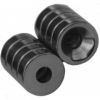Magnetic Science Experiment
Neodymium magnets are not only useful for organizing clutter or making crafts, but also for demonstrating the unique properties of magnetism and magnetic fields. If you’re looking for an easy and fun science experiment, check out this magnetic tutorial for a hollow pyramid with a ring magnet:
Supplies:
- Neodymium ring or countersunk ring magnet
- 6 skewers or popsicle sticks (about 12 inches long)
- 3 neodymium bar magnets
- Small rubber bands
- Yarn or string
Directions:
- First, cut about 8 inches of string and tie the string securely through the ring magnet.
- Next, create the base of your pyramid shape by connecting 3 of the skewers using the small rubber bands. You can secure the ends of the 3 skewers together to create a triangle.
- To finish creating the pyramid shape, take the 3 remaining skewers and connect them all loosely at one end using string. This end will be the apex of your pyramid. The other ends of the 3 skewers should attach to the 3 corners of your base triangle. You can use string or rubber bands to secure them tightly to the corners.
- Once you have a pyramid shape, remove the loosely tied string from the apex of your pyramid. Take the string you tied to the ring magnet and secure the point of your pyramid with the other end of the string. You can tie it so that the ring magnet dangles down the center of the pyramid.

